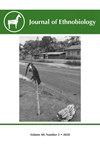Bec(墨西哥):经典玛雅低地聚落农业研究进展(2019-2022
IF 1.3
3区 社会学
Q1 ANTHROPOLOGY
引用次数: 1
摘要
摘要关于农业在古典(公元250-950年)玛雅低地社会的发展和衰落中所起的作用,目前正在进行的辩论中,Río Bec考古遗址具有特殊的地位。在使用激光雷达调查Yucatán半岛的几年前,一项多标量地质考古研究(Río Bec项目1,2002-2010)使我们能够定义一个领域系统,即围绕其当地家庭单位网络组织的不同领域的着陆域,这是少数几个定居点之一。在Río Bec的鼎盛时期,田地的规模、它们与相应家庭规模的相关性以及它们的长期使用(200年,公元700-900年),提出了关于土地使用实践(集约化、多样化和专业化)的基本问题及其在相对较长时期内的可持续性的问题。这些问题是Río Bec新研究项目的核心,我们于2019年开始该项目,将考古学方法与土地利用和定居模式建模相结合,最终旨在将当地农业生产与人口统计学联系起来(Río Bec项目2,2019 - 2022)。基于以往研究中积累的田野系统和聚落系统的知识,本文首先描述了Río贝克遗址的一个区域的田野系统,然后关注其在家庭尺度上的地块多样性,并进一步讨论了Río贝克在社区尺度和聚落尺度上的农业集约化与人口统计学之间的初步相关性。本文章由计算机程序翻译,如有差异,请以英文原文为准。
Fields and People at Río Bec (Mexico): A Study in Progress (2019-2022) of Settlement Agriculture in the Classic Maya Lowlands
Abstract. In the ongoing debate about the role of agriculture in the development and decline of Classic (250–950 CE) Maya lowland societies, the archaeological site of Río Bec has a special place. It is one of the few settlements in which, years before the use of LiDAR to survey the Yucatán peninsula, a multi-scalar geoarchaeological study (Río Bec Project 1, 2002–2010) allowed us to define a field system—that is, landed domains of distinct fields organized around their local networks of household units. The dimensions of the fields, their correlation to the size of their corresponding households, and their long period of use (200 years, 700–900 CE), during Río Bec's apogee, raise questions about the fundamental issues of land use practices (intensification, diversification, and specialization) and their sustainability over what was a relatively long period. Those issues are at the heart of a new research program at Río Bec, which we began in 2019, combining an archaeobotanical approach with land use and settlement pattern modeling, ultimately aimed at correlating local agricultural production with demography (Río Bec Project 2, 2019–2022). Based on the knowledge of field and settlement systems in their environment that we accumulated during our past research, the paper starts with a description of the field system in one sector of the Río Bec site, then focuses on the diversity of its plots on the household scale and proceeds to discuss the preliminary correlation that can be established between agricultural intensification and demography at Río Bec at the neighborhood scale and the settlement scale.
求助全文
通过发布文献求助,成功后即可免费获取论文全文。
去求助
来源期刊

Journal of Ethnobiology
Social Sciences-Anthropology
CiteScore
4.80
自引率
3.40%
发文量
21
审稿时长
>12 weeks
期刊介绍:
JoE’s readership is as wide and diverse as ethnobiology itself, with readers spanning from both the natural and social sciences. Not surprisingly, a glance at the papers published in the Journal reveals the depth and breadth of topics, extending from studies in archaeology and the origins of agriculture, to folk classification systems, to food composition, plants, birds, mammals, fungi and everything in between.
Research areas published in JoE include but are not limited to neo- and paleo-ethnobiology, zooarchaeology, ethnobotany, ethnozoology, ethnopharmacology, ethnoecology, linguistic ethnobiology, human paleoecology, and many other related fields of study within anthropology and biology, such as taxonomy, conservation biology, ethnography, political ecology, and cognitive and cultural anthropology.
JoE does not limit itself to a single perspective, approach or discipline, but seeks to represent the full spectrum and wide diversity of the field of ethnobiology, including cognitive, symbolic, linguistic, ecological, and economic aspects of human interactions with our living world. Articles that significantly advance ethnobiological theory and/or methodology are particularly welcome, as well as studies bridging across disciplines and knowledge systems. JoE does not publish uncontextualized data such as species lists; appropriate submissions must elaborate on the ethnobiological context of findings.
 求助内容:
求助内容: 应助结果提醒方式:
应助结果提醒方式:


